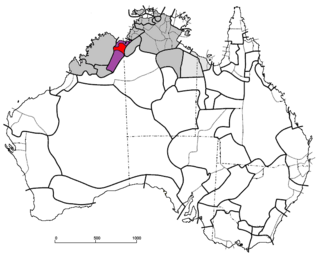| Doolboong | |
|---|---|
| Region | Northern Territory |
| Ethnicity | Doolboong |
| Extinct | (date missing) |
| Language codes | |
| ISO 639-3 | None (mis) |
| Glottolog | None |
| AIATSIS [1] | K50 |
Doolboong (also Tulpung or Duulngari [2] ) is an extinct Australian Aboriginal language formerly spoken by the Doolboong on the coast of the Cambridge Gulf in the Northern Territory.

In linguistics, language death occurs when a language loses its last native speaker. By extension, language extinction is when the language is no longer known, including by second-language speakers. Other similar terms include linguicide, the death of a language from natural or political causes, and rarely glottophagy, the absorption or replacement of a minor language by a major language.

The Australian Aboriginal languages consist of around 290–363 languages belonging to an estimated 28 language families and isolates, spoken by Aboriginal Australians of mainland Australia and a few nearby islands. The relationships between these languages are not clear at present. Despite this uncertainty, the Indigenous Australians' languages are collectively covered by the technical term "Australian languages", or the "Australian family".
There are no longer any speakers of Doolboong, and no written records of it exist. However, speakers of the nearby Gajirrabeng and Miriwoong languages say it was similar to Gajirrabeng. [3] This would place it in the Jarrakan family; however, it may instead belong to the neighbouring Worrorran family. [2]

Miriwoong (Miriwung) is an Australian Indigenous language which today has fewer than 20 fluent speakers, most of whom live in or near Kununurra in Western Australia. All of the fluent speakers are elderly and the Miriwoong language is considered to be critically endangered. However, younger generations tend to be familiar with a lot of Miriwoong vocabulary which they use when speaking Kimberley Kriol or Aboriginal English.

The Jarrakanlanguages are a small family of Australian Aboriginal languages spoken in northern Australia. The name is derived from the word jarrak, which means "language" in Kija.

The Worrorran (Wororan) languages are a small family of Australian Aboriginal languages spoken in northern Western Australia.

